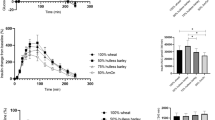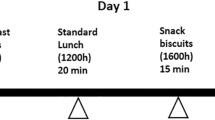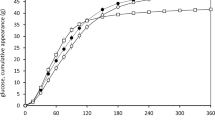Abstract
Objectives:
To determine the possible differences in glycaemic index (GI) depending on (1) the analytical method used to calculate the ‘available carbohydrate’ load, that is, using carbohydrates by difference (total carbohydrate by difference, minus dietary fibre (DF)) as available carbohydrates vs available starch basis (total starch minus resistant starch (RS)) of a food rich in intrinsic RS and (2) the effect of GI characteristics and/or the content of indigestible carbohydrates (RS and DF) of the evening meal prior to GI testing the following morning.
Design:
Blood glucose and serum insulin responses were studied after subjects consuming (1) two levels of barley kernels rich in intrinsic RS (15.2%, total starch basis) and (2) after a standard breakfast following three different evening meals varying in GI and/or indigestible carbohydrates: pasta, barley kernels and white wheat bread, respectively.
Subjects:
Healthy adults with normal body mass index.
Results:
(1) Increasing the portion size of barley kernels from 79.6 g (50 g ‘available carbohydrates’) to 93.9 g (50 g available starch) to adjust for its RS content did not significantly affect the GI or insulin index (II). (2) The low GI barley evening meal, as opposed to white wheat bread and pasta evening meals, reduced the postprandial glycaemic and insulinaemic (23 and 29%, respectively, P<0.05) areas under the curve at a standardized white bread breakfast fed the following morning.
Conclusion:
(1) Increasing portion size to compensate for the considerable portion of RS in a low GI barley product had no significant impact on GI or II. However, for GI testing, it is recommended to base carbohydrate load on specific analyses of the available carbohydrate content. (2) A low GI barley evening meal containing high levels of indigestible carbohydrates (RS and DF) substantially reduced the GI and II of white wheat bread determined at a subsequent breakfast meal.
This is a preview of subscription content, access via your institution
Access options
Subscribe to this journal
Receive 12 print issues and online access
$259.00 per year
only $21.58 per issue
Buy this article
- Purchase on Springer Link
- Instant access to full article PDF
Prices may be subject to local taxes which are calculated during checkout




Similar content being viewed by others

References
Åkerberg AKE, Liljeberg HGM, Granfeldt YE, Drews A, Björck IM (1998). An in vitro method, based on chewing, to predict resistant starch content in foods allows parallel determination of potentially available starch and dietary fibre. J Nutr 651–659.
AOAC (1995). Offical Methods of Analysis, 16th edn. Association of Official Analytical Chemists: Arlington, VA.
Asp N-G, Johansson C-G, Hallmer H, Siljeström M (1983). Rapid enzymatic assay of insoluble and soluble dietary fibre. J Agric Food Chem 31, 476–482.
Björck IME (1996). Starch: nutritional aspects. In: Eliasson A-C (ed). Carbohydrates in Food. Marcel-Dekker Inc.: New York. pp 505–554.
Björck IME, Liljeberg HGM, Östman EM (2000). Low glycaemic-index foods. Br J Nutr 83, S149–S155.
Brand J, Colagiuri S, Crossman S, Allen A, Roberts D, Truswell S (1991). Low-glycemic index foods improve long term glycemic control in NIDDM. Diabetes Care 14, 95–101.
Brand-Miller JC, Thomas M, Swan V, Ahmad ZI, Petocz P, Colagiuri S (2003). Physiological validation of the concept of glycemic load in lean young adults. J Nutr 133, 2728–2732.
Bravata DM, Sanders L, Huang J, Krumholz HM, Olkin I, Gardner CD et al. (2003). Efficacy and safety of low-carbohydrate diets: a systematic review. J Am Med Assoc 289, 1837–1850.
Brouns F, Björck I, Frayn KN, Gibbs AL, Lang V, Slama G, Wolever TMS (2005). Glycaemic index methodology. Nutr Res Rev 18, 145–171.
DelPrato S, Leonetti F, Simonson DC, Sheehan P, Matsuda M, DeFronzo RA (1994). Effect of sustained physiologic hyperinsulinaemia and hyperglycaemia on insulin secretion and insulin sensitivity in man. Diabetologia 37, 1025–1035.
Englyst HN, Kingman SM, Cummings JH (1992). Classification and measurement of nutritionally important starch fractions. Eur J Clin Nutr 46, S33–S50.
Faisant N, Pianchot V, Koziowski F, Pacouret MP, Colonna P, Champ M (1995). Resistant starch determination adapted to products containing high level od resistent starch. Sci Aliment 15, 83–89.
FAO/WHO (1998). Carbohydrates in human nutrition: report of a joint FAO/WHO expert consultation. FAO Food and Nutrition Paper 66, 1–140.
FAO/WHO (2003). Report: Diet, nutrition and the prevention of chronic diseases: report of a joint WHO/FAO expert consultation WHO Technical Report Series, vol. 916.
Fontvieille AM, Rizkalla SW, Penfornis A, Acosta M, Bornet FR, Slama G (1992). The use of low glycaemic index foods improves metabolic control of diabetic patients over five weeks. Diabet Med 9, 444–450.
Foster-Powell K, Holt SH, Brand-Miller JC (2002). International table of glycemic index and glycemic load values: 2002. Am J Clin Nutr 76, 5–56.
Granfeldt YE, Björck IME, Hagander B (1991). On the importance of processing conditions, product thickness and egg addition for the glycaemia and hormonal responses to pasta: a comparison with bread made from ‘pasta ingredients’. Eur J Clin Nutr 45, 489–499.
Granfeldt YE, Drews A, Björck IME (1995). Arepas made from high-amylose corn flour produce favourably low glucose and insulin responses in healthy humans. J Nutr 125, 459–465.
Holm J, Björck IME, Drews A, Asp N-G (1986). A rapid method for the analysis of starch. Starch/Stärke 38, 224–226.
Järvi AE, Karlström BE, Granfeldt YE, Björck IME, Asp N-G, Vessby BOH (1999). Improved glycemic control and lipid profile and nomalized fibrinolytic activity on a low-glycemic index diet in type 2 diabetic patients. Diabetes Care 22, 10–18.
Jenkins DJA, Cuff D, Wolever TMS, Knowland D, Thompson L, Cohen Z et al. (1987a). Digestibility of carbohydrate foods in an ileostomate: relationship to dietary fibre, in vitro digestibility and glycemic response. Am J Gastroenterol 82, 709–717.
Jenkins DJA, Wolever TMS, Buckley G, Lam KY, Giudici S, Kalmusky J et al. (1988). Low-glycemic-index starchy foods in the diabetic diet. Am J Clin Nutr 48, 248–254.
Jenkins DJA, Wolever TMS, Kalmusky J, Guidici S, Giordano C, Patten R et al. (1987b). Low-glycemic index diet in hyperlipidemia: use of traditional starchy foods. Am J Clin Nutr 46, 66–71.
Jenkins DJA, Wolever TMS, Nineham R, Sarson DL, Bloom SR, Ahern J et al. (1980). Improved glucose tolerance four hours after taking guar with glucose. Diabetologia 19, 21–24.
Liljeberg H, Bjorck I (2000). Effects of a low-glycaemic index spaghetti meal on glucose tolerance and lipaemia at a subsequent meal in healthy subjects. Eur J Clin Nutr 54, 24–28.
Liljeberg HGM, Björck IME (1994). Bioavailability of starch in bread products. Postprandial glucose and insulin responses in healthy subjects and in vitro resistant starch content. Eur J Clin Nutr 48, 151–163.
Liljeberg HGM, Kerberg AKE, Björck IME (1999). Effect of the glycemic index and content of indigestible carbohydrates of cereal-based breakfast meals on glucose tolerance at lunch in healthy subjects. Am J Clin Nutr 69, 647–655.
McKeown NM, Meigs JB, Liu S, Saltzman E, Wilson PWF, Jaques PF (2004). Carbohydrate nutrition, insulin resistance, and the prevalence of the metabolic syndrome in the Framingham offspring cohort. Diabetes Care 27, 538–546.
Östman EM, Elmståhl HGL, Björck IME (2002). Barley bread containing lactic acid improves glucose tolerance at a subsequent meal in healthy men and women. J Nutr 132, 1173–1175.
Östman EM, Liljeberg Elmståhl HGM, Björck IME (2001). Inconsistency between glycemic and insulinemic responses to regular and fermented milk products. Am J Clin Nutr 74, 96–100.
Salmerón J, Ascherio A, Rimm EB, Colditz GA, Spiegelman D, Jenkins DJ et al. (1997a). Dietary fibre, glycemic load, and risk of NIDDM in men. Diabetes Care 20, 545–550.
Salmerón J, Manson JE, Stampfer MJ, Colditz GA, Wing AL, Willett WC (1997b). Dietary fibre, glycemic load, and risk of non-insulin-dependent diabetes mellitus in women. J Am Med Assoc 277, 472–477.
Thorburn A, Muir J, Proitto J (1993). Carbohydrate fermentation lowers hepatic glucose output in healthy subjects. Metabolism 42, 780–785.
Venter CS, Vorster HH, Cummings JH (1990). Effects of dietary propionate on carbohydrate and lipid metabolism in healthy volunteers. Am J Gastroenterol 85, 549–553.
Wolever TM, Vorster HH, Björck I, Brand-Miller J, Brighenti F, Mann JI et al. (2003). Determination of the glycaemic index of foods: interlaboratory study. Eur J Clin Nutr 57, 475–482.
Wolever TMS, Bolognesi C (1996). Source and amount of carbohydrate affect postprandial glucose and insulin in normal subjects. J Nutr 126, 2798–2806.
Wolever TMS, Brighenti F, Royall D (1989). Effect of rectal infusion of short chain fatty acids in human subjects. Am J Gastroenterol 84, 1027–1037.
Wolever TMS, Jenkins DJA, Ocana AM, Rao VA, Collier GR (1988). Second-meal effect: low-glycemic-index foods eaten at dinner improve subsequent breakfast glycemic response. Am J Clin Nutr 48, 1041–1047.
Author information
Authors and Affiliations
Corresponding author
Additional information
Guarantor: Y Granfeldt.
Contributor: YG and XW carried out the experiments and evaluated the results. IB and YG designed the experiments and were responsible for writing the manuscript.
Rights and permissions
About this article
Cite this article
Granfeldt, Y., Wu, X. & Björck, I. Determination of glycaemic index; some methodological aspects related to the analysis of carbohydrate load and characteristics of the previous evening meal. Eur J Clin Nutr 60, 104–112 (2006). https://doi.org/10.1038/sj.ejcn.1602273
Received:
Revised:
Accepted:
Published:
Issue Date:
DOI: https://doi.org/10.1038/sj.ejcn.1602273
Keywords
This article is cited by
-
Influence of resistant starch resulting from the cooling of rice on postprandial glycemia in type 1 diabetes
Nutrition & Diabetes (2022)
-
Sea buckthorn decreases and delays insulin response and improves glycaemic profile following a sucrose-containing berry meal: a randomised, controlled, crossover study of Danish sea buckthorn and strawberries in overweight and obese male subjects
European Journal of Nutrition (2018)
-
Postprandial glucose metabolism and SCFA after consuming wholegrain rye bread and wheat bread enriched with bioprocessed rye bran in individuals with mild gastrointestinal symptoms
Nutrition Journal (2014)
-
In vitro and in vivo assessment of the glycemic index of bakery products: influence of the reformulation of ingredients
European Journal of Nutrition (2012)
-
Muesli with 4 g oat β-glucans lowers glucose and insulin responses after a bread meal in healthy subjects
European Journal of Clinical Nutrition (2008)


